Auditing 12 Report: Analyzing Executive Performance and Remuneration
VerifiedAdded on 2021/05/31
|13
|2885
|78
Report
AI Summary
This report, prepared for an Auditing 12 assignment, evaluates executive performance and remuneration in public companies, focusing on the National Australia Bank (NAB). The report begins with an introduction to the topic and a review of relevant literature on short-term and long-term incentive (STI and LTI) methods, including bonus schemes, share options, and non-financial measures. The report then analyzes NAB's remuneration practices, examining its STI and LTI plans, performance measures (such as cash return on equity and total shareholder return), and the allocation methodologies used. Findings reveal differences between methods discussed in literature and practical applications. The report concludes with recommendations for improving performance measures and a focus on aligning employee performance with compensation plans. This report is a comprehensive analysis of executive compensation strategies.

Running head: ACCOUNTING
Accounting
University Name
Student Name
Authors’ Note
Accounting
University Name
Student Name
Authors’ Note
Paraphrase This Document
Need a fresh take? Get an instant paraphrase of this document with our AI Paraphraser

2
AUDITING
Table of Contents
Introduction:...............................................................................................................................4
Discussion:.................................................................................................................................5
Review of literature:...................................................................................................................5
Company review:.......................................................................................................................6
Summary of findings:.................................................................................................................8
Analysis of remuneration method used:.....................................................................................8
Recommendation:....................................................................................................................12
Conclusion:..............................................................................................................................12
References lists:.......................................................................................................................14
AUDITING
Table of Contents
Introduction:...............................................................................................................................4
Discussion:.................................................................................................................................5
Review of literature:...................................................................................................................5
Company review:.......................................................................................................................6
Summary of findings:.................................................................................................................8
Analysis of remuneration method used:.....................................................................................8
Recommendation:....................................................................................................................12
Conclusion:..............................................................................................................................12
References lists:.......................................................................................................................14
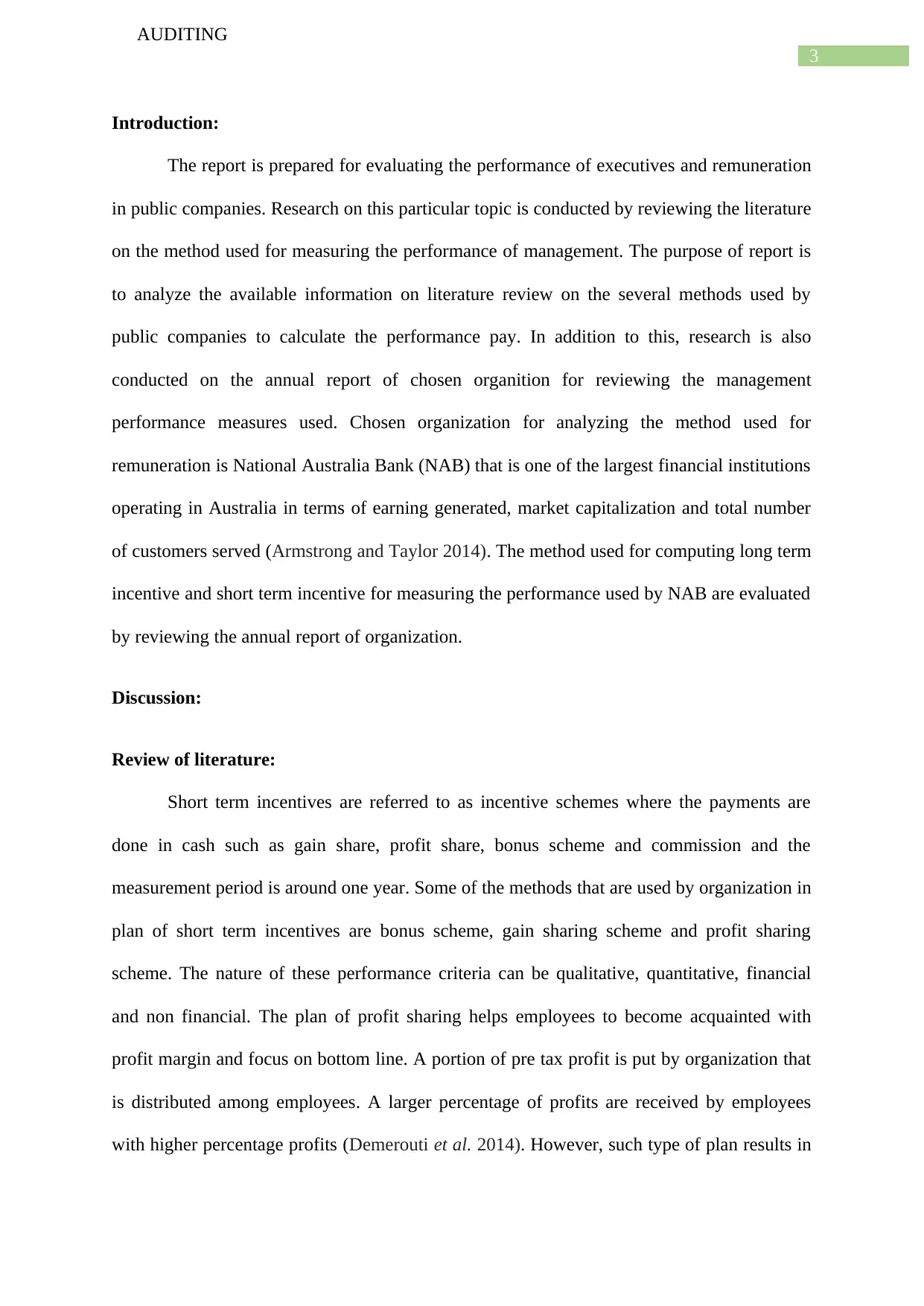
3
AUDITING
Introduction:
The report is prepared for evaluating the performance of executives and remuneration
in public companies. Research on this particular topic is conducted by reviewing the literature
on the method used for measuring the performance of management. The purpose of report is
to analyze the available information on literature review on the several methods used by
public companies to calculate the performance pay. In addition to this, research is also
conducted on the annual report of chosen organition for reviewing the management
performance measures used. Chosen organization for analyzing the method used for
remuneration is National Australia Bank (NAB) that is one of the largest financial institutions
operating in Australia in terms of earning generated, market capitalization and total number
of customers served (Armstrong and Taylor 2014). The method used for computing long term
incentive and short term incentive for measuring the performance used by NAB are evaluated
by reviewing the annual report of organization.
Discussion:
Review of literature:
Short term incentives are referred to as incentive schemes where the payments are
done in cash such as gain share, profit share, bonus scheme and commission and the
measurement period is around one year. Some of the methods that are used by organization in
plan of short term incentives are bonus scheme, gain sharing scheme and profit sharing
scheme. The nature of these performance criteria can be qualitative, quantitative, financial
and non financial. The plan of profit sharing helps employees to become acquainted with
profit margin and focus on bottom line. A portion of pre tax profit is put by organization that
is distributed among employees. A larger percentage of profits are received by employees
with higher percentage profits (Demerouti et al. 2014). However, such type of plan results in
AUDITING
Introduction:
The report is prepared for evaluating the performance of executives and remuneration
in public companies. Research on this particular topic is conducted by reviewing the literature
on the method used for measuring the performance of management. The purpose of report is
to analyze the available information on literature review on the several methods used by
public companies to calculate the performance pay. In addition to this, research is also
conducted on the annual report of chosen organition for reviewing the management
performance measures used. Chosen organization for analyzing the method used for
remuneration is National Australia Bank (NAB) that is one of the largest financial institutions
operating in Australia in terms of earning generated, market capitalization and total number
of customers served (Armstrong and Taylor 2014). The method used for computing long term
incentive and short term incentive for measuring the performance used by NAB are evaluated
by reviewing the annual report of organization.
Discussion:
Review of literature:
Short term incentives are referred to as incentive schemes where the payments are
done in cash such as gain share, profit share, bonus scheme and commission and the
measurement period is around one year. Some of the methods that are used by organization in
plan of short term incentives are bonus scheme, gain sharing scheme and profit sharing
scheme. The nature of these performance criteria can be qualitative, quantitative, financial
and non financial. The plan of profit sharing helps employees to become acquainted with
profit margin and focus on bottom line. A portion of pre tax profit is put by organization that
is distributed among employees. A larger percentage of profits are received by employees
with higher percentage profits (Demerouti et al. 2014). However, such type of plan results in
⊘ This is a preview!⊘
Do you want full access?
Subscribe today to unlock all pages.

Trusted by 1+ million students worldwide
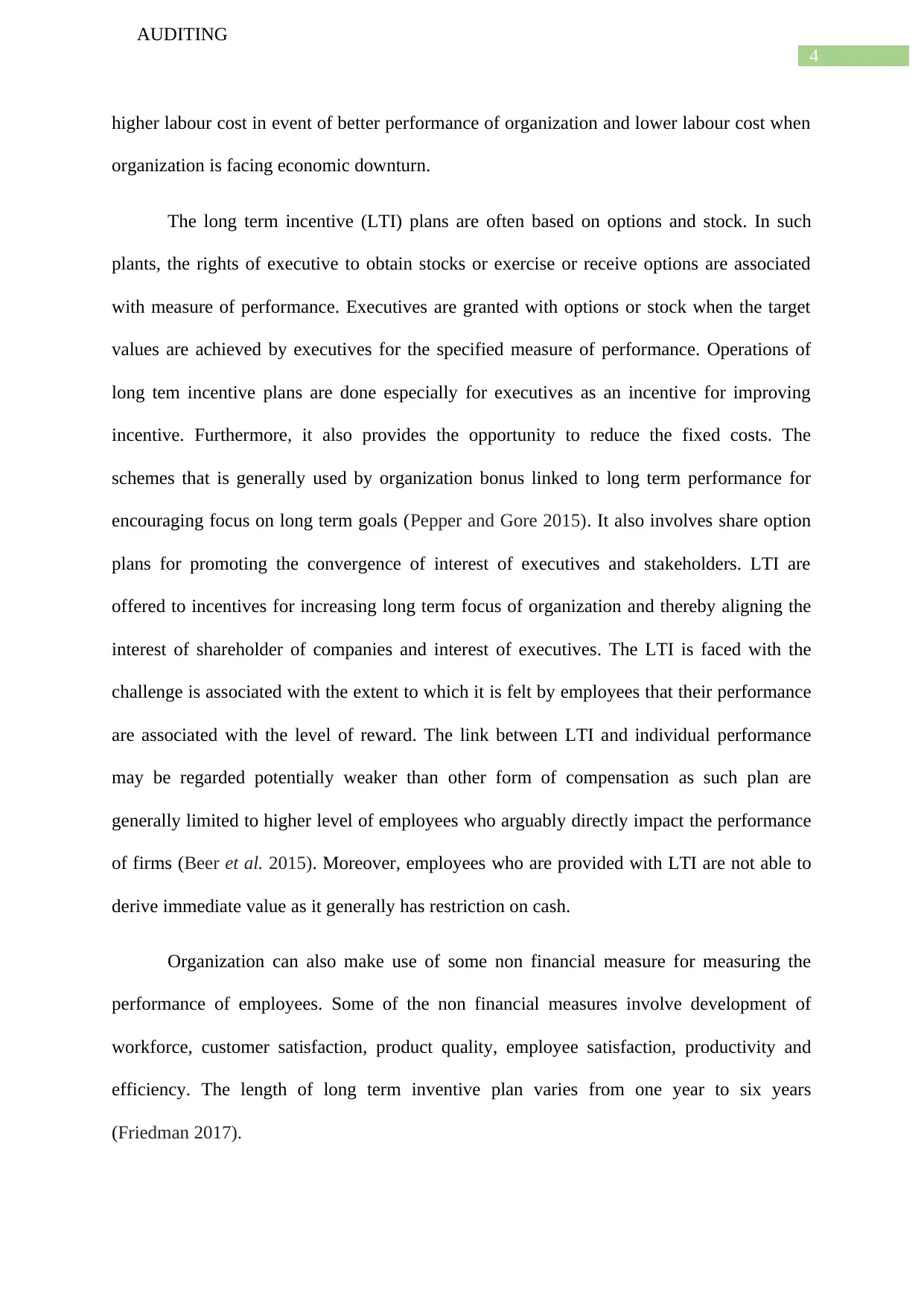
4
AUDITING
higher labour cost in event of better performance of organization and lower labour cost when
organization is facing economic downturn.
The long term incentive (LTI) plans are often based on options and stock. In such
plants, the rights of executive to obtain stocks or exercise or receive options are associated
with measure of performance. Executives are granted with options or stock when the target
values are achieved by executives for the specified measure of performance. Operations of
long tem incentive plans are done especially for executives as an incentive for improving
incentive. Furthermore, it also provides the opportunity to reduce the fixed costs. The
schemes that is generally used by organization bonus linked to long term performance for
encouraging focus on long term goals (Pepper and Gore 2015). It also involves share option
plans for promoting the convergence of interest of executives and stakeholders. LTI are
offered to incentives for increasing long term focus of organization and thereby aligning the
interest of shareholder of companies and interest of executives. The LTI is faced with the
challenge is associated with the extent to which it is felt by employees that their performance
are associated with the level of reward. The link between LTI and individual performance
may be regarded potentially weaker than other form of compensation as such plan are
generally limited to higher level of employees who arguably directly impact the performance
of firms (Beer et al. 2015). Moreover, employees who are provided with LTI are not able to
derive immediate value as it generally has restriction on cash.
Organization can also make use of some non financial measure for measuring the
performance of employees. Some of the non financial measures involve development of
workforce, customer satisfaction, product quality, employee satisfaction, productivity and
efficiency. The length of long term inventive plan varies from one year to six years
(Friedman 2017).
AUDITING
higher labour cost in event of better performance of organization and lower labour cost when
organization is facing economic downturn.
The long term incentive (LTI) plans are often based on options and stock. In such
plants, the rights of executive to obtain stocks or exercise or receive options are associated
with measure of performance. Executives are granted with options or stock when the target
values are achieved by executives for the specified measure of performance. Operations of
long tem incentive plans are done especially for executives as an incentive for improving
incentive. Furthermore, it also provides the opportunity to reduce the fixed costs. The
schemes that is generally used by organization bonus linked to long term performance for
encouraging focus on long term goals (Pepper and Gore 2015). It also involves share option
plans for promoting the convergence of interest of executives and stakeholders. LTI are
offered to incentives for increasing long term focus of organization and thereby aligning the
interest of shareholder of companies and interest of executives. The LTI is faced with the
challenge is associated with the extent to which it is felt by employees that their performance
are associated with the level of reward. The link between LTI and individual performance
may be regarded potentially weaker than other form of compensation as such plan are
generally limited to higher level of employees who arguably directly impact the performance
of firms (Beer et al. 2015). Moreover, employees who are provided with LTI are not able to
derive immediate value as it generally has restriction on cash.
Organization can also make use of some non financial measure for measuring the
performance of employees. Some of the non financial measures involve development of
workforce, customer satisfaction, product quality, employee satisfaction, productivity and
efficiency. The length of long term inventive plan varies from one year to six years
(Friedman 2017).
Paraphrase This Document
Need a fresh take? Get an instant paraphrase of this document with our AI Paraphraser

5
AUDITING
Company review:
National Australia bank is the financial service providers of Australia that intend to
achieve their business objectives by building relationship in segments such as medium and
small businesses and deliver greater customer experience. The remuneration decision within
the organization is supported by way of easing leaders and lead to embedding and
introduction of a new market based pay range methodology. Remuneration policy of
company is built around creating linkage for rewarding value of shareholders and retaining
and attracting high performing employees.
Long term incentives plan of NAB takes the form of performance rights that assist in
aligning the long term performance of group with decision of management by using
challenging performance hurdles. Senior executives across the group are awarded with
executive LTI program. Maximum opportunity of LTI is set with reference to external and
internal relativities for executives who must meet the minimum conduct and performance
threshold (Shields et al. 2015). The performance measure that is used for awarding LTI is the
total shareholder return and cash return on equity growth. Allocation of LTI is done under the
LTI program of group in the form of performance rights. The performance right associated
with LTI is a performance right that is granted under the plan and is subjected to long term
performance hurdles. For grant of year 2017, the allocation methodology for LTI has been
changes from fair value to face value that helps in determining the number of performance
rights. LTI is based on minimum grant value of 130% of fixed remuneration.
AUDITING
Company review:
National Australia bank is the financial service providers of Australia that intend to
achieve their business objectives by building relationship in segments such as medium and
small businesses and deliver greater customer experience. The remuneration decision within
the organization is supported by way of easing leaders and lead to embedding and
introduction of a new market based pay range methodology. Remuneration policy of
company is built around creating linkage for rewarding value of shareholders and retaining
and attracting high performing employees.
Long term incentives plan of NAB takes the form of performance rights that assist in
aligning the long term performance of group with decision of management by using
challenging performance hurdles. Senior executives across the group are awarded with
executive LTI program. Maximum opportunity of LTI is set with reference to external and
internal relativities for executives who must meet the minimum conduct and performance
threshold (Shields et al. 2015). The performance measure that is used for awarding LTI is the
total shareholder return and cash return on equity growth. Allocation of LTI is done under the
LTI program of group in the form of performance rights. The performance right associated
with LTI is a performance right that is granted under the plan and is subjected to long term
performance hurdles. For grant of year 2017, the allocation methodology for LTI has been
changes from fair value to face value that helps in determining the number of performance
rights. LTI is based on minimum grant value of 130% of fixed remuneration.
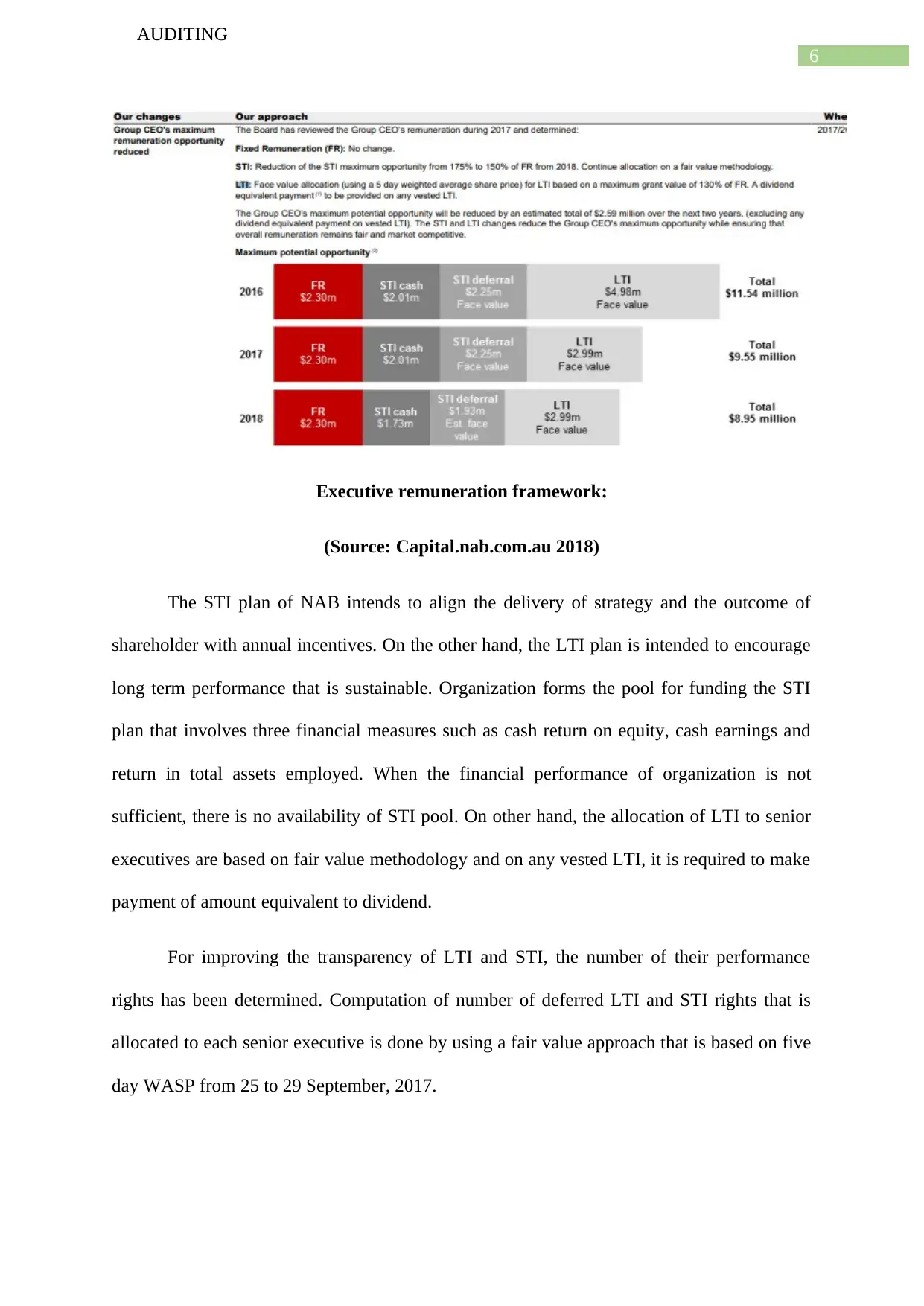
6
AUDITING
Executive remuneration framework:
(Source: Capital.nab.com.au 2018)
The STI plan of NAB intends to align the delivery of strategy and the outcome of
shareholder with annual incentives. On the other hand, the LTI plan is intended to encourage
long term performance that is sustainable. Organization forms the pool for funding the STI
plan that involves three financial measures such as cash return on equity, cash earnings and
return in total assets employed. When the financial performance of organization is not
sufficient, there is no availability of STI pool. On other hand, the allocation of LTI to senior
executives are based on fair value methodology and on any vested LTI, it is required to make
payment of amount equivalent to dividend.
For improving the transparency of LTI and STI, the number of their performance
rights has been determined. Computation of number of deferred LTI and STI rights that is
allocated to each senior executive is done by using a fair value approach that is based on five
day WASP from 25 to 29 September, 2017.
AUDITING
Executive remuneration framework:
(Source: Capital.nab.com.au 2018)
The STI plan of NAB intends to align the delivery of strategy and the outcome of
shareholder with annual incentives. On the other hand, the LTI plan is intended to encourage
long term performance that is sustainable. Organization forms the pool for funding the STI
plan that involves three financial measures such as cash return on equity, cash earnings and
return in total assets employed. When the financial performance of organization is not
sufficient, there is no availability of STI pool. On other hand, the allocation of LTI to senior
executives are based on fair value methodology and on any vested LTI, it is required to make
payment of amount equivalent to dividend.
For improving the transparency of LTI and STI, the number of their performance
rights has been determined. Computation of number of deferred LTI and STI rights that is
allocated to each senior executive is done by using a fair value approach that is based on five
day WASP from 25 to 29 September, 2017.
⊘ This is a preview!⊘
Do you want full access?
Subscribe today to unlock all pages.

Trusted by 1+ million students worldwide
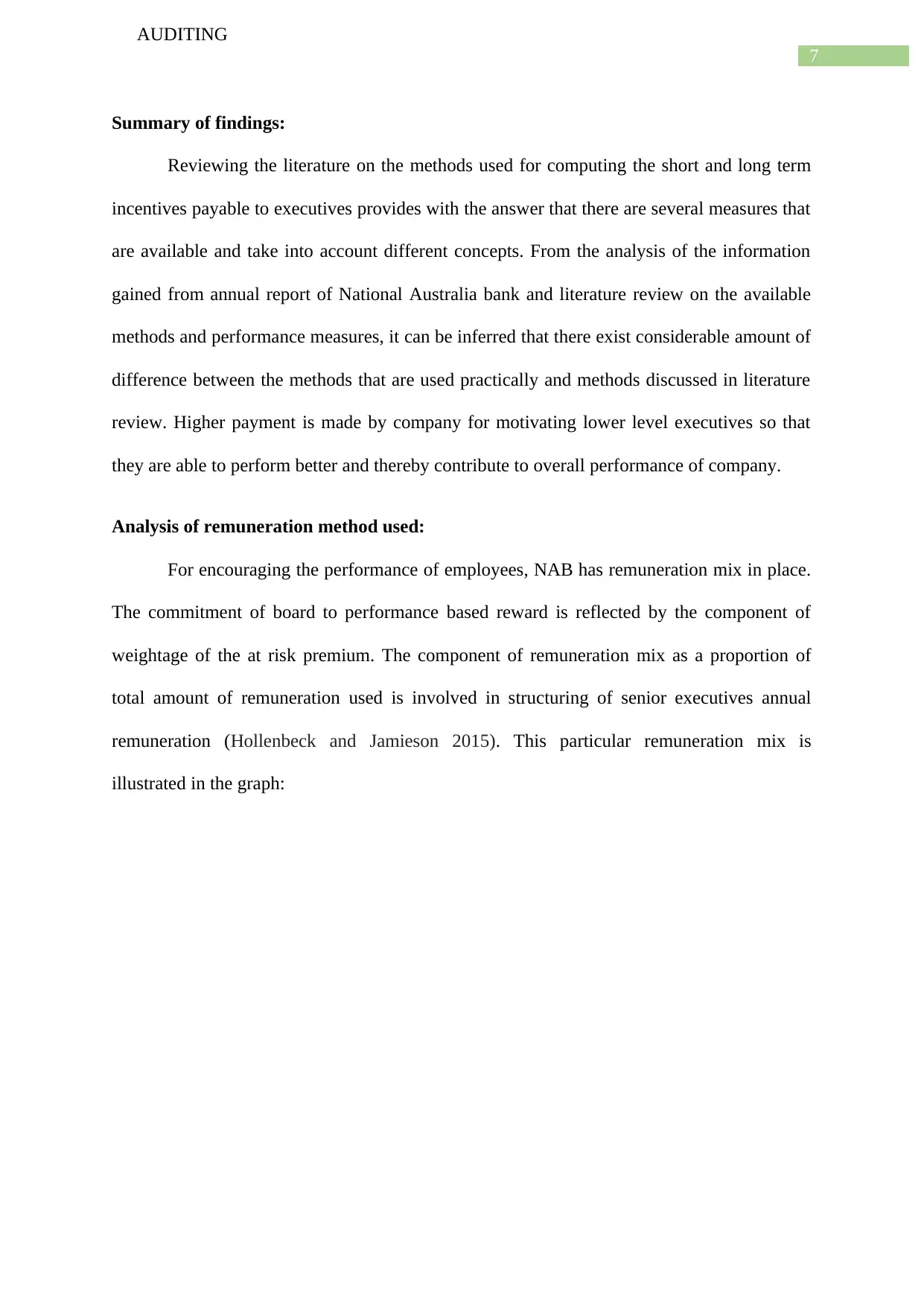
7
AUDITING
Summary of findings:
Reviewing the literature on the methods used for computing the short and long term
incentives payable to executives provides with the answer that there are several measures that
are available and take into account different concepts. From the analysis of the information
gained from annual report of National Australia bank and literature review on the available
methods and performance measures, it can be inferred that there exist considerable amount of
difference between the methods that are used practically and methods discussed in literature
review. Higher payment is made by company for motivating lower level executives so that
they are able to perform better and thereby contribute to overall performance of company.
Analysis of remuneration method used:
For encouraging the performance of employees, NAB has remuneration mix in place.
The commitment of board to performance based reward is reflected by the component of
weightage of the at risk premium. The component of remuneration mix as a proportion of
total amount of remuneration used is involved in structuring of senior executives annual
remuneration (Hollenbeck and Jamieson 2015). This particular remuneration mix is
illustrated in the graph:
AUDITING
Summary of findings:
Reviewing the literature on the methods used for computing the short and long term
incentives payable to executives provides with the answer that there are several measures that
are available and take into account different concepts. From the analysis of the information
gained from annual report of National Australia bank and literature review on the available
methods and performance measures, it can be inferred that there exist considerable amount of
difference between the methods that are used practically and methods discussed in literature
review. Higher payment is made by company for motivating lower level executives so that
they are able to perform better and thereby contribute to overall performance of company.
Analysis of remuneration method used:
For encouraging the performance of employees, NAB has remuneration mix in place.
The commitment of board to performance based reward is reflected by the component of
weightage of the at risk premium. The component of remuneration mix as a proportion of
total amount of remuneration used is involved in structuring of senior executives annual
remuneration (Hollenbeck and Jamieson 2015). This particular remuneration mix is
illustrated in the graph:
Paraphrase This Document
Need a fresh take? Get an instant paraphrase of this document with our AI Paraphraser

8
AUDITING
Remuneration mix for encouraging performance:
(Source: Capital.nab.com.au 2018)
Chief legal and chief executive officer plays a very important role in maintaining the
oversight of risk and financial performance of employees and group. The reward mix for such
roles is structured that helps in recognizing the responsibilities and supporting the
independence roles by offering higher proportion of fixed amount of remuneration. Great
emphasis is placed on the component of LTI rather than STI of their variable reward. Some
of the financial performance measures used by NAB include statutory return on equity, cash
earnings, net interest margin, average equity, average assets and average interest earning
assets (McKeown et al. 2015).
LTI and performance measures:
AUDITING
Remuneration mix for encouraging performance:
(Source: Capital.nab.com.au 2018)
Chief legal and chief executive officer plays a very important role in maintaining the
oversight of risk and financial performance of employees and group. The reward mix for such
roles is structured that helps in recognizing the responsibilities and supporting the
independence roles by offering higher proportion of fixed amount of remuneration. Great
emphasis is placed on the component of LTI rather than STI of their variable reward. Some
of the financial performance measures used by NAB include statutory return on equity, cash
earnings, net interest margin, average equity, average assets and average interest earning
assets (McKeown et al. 2015).
LTI and performance measures:

9
AUDITING
(Source: Capital.nab.com.au 2018)
The above table depicts the annual performance of organization over the last five
years on the value of shareholders by taking into account any changes in share price, dividend
payment and other adjustments in capital.
The allocation methodology used by NAB for short term incentives plan is fair value
for all senior executives. Outcome of STI ranges from 0% to maximum opportunity. 50%
deferred and 50% cash is provided as performance rights and only if the performance and
service conditions are met, then only organization vest into deferred conditions. Depending
on the allocation value, the outcome of LTI may range from 0% to 100%. Under LTI reward,
100% is provided as performance rights (Capital.nab.com.au 2018).
Remuneration of CEO of group is reviewed by the group during year 2017. The fair
value allocation methodology is used in determining the STI and there would be reduction of
maximum opportunity from 175% to 150% if fixed remuneration form year 2018. On other
hand, the LTI is determined by using face value allocation. Such allocation involves using
five day weighted average share price based maximum grant value of 130% of fixed
remuneration. This would lead to reduction of maximum potential opportunity of CEO over
the next two years by an estimated amount of $ 2.59 million. Maximum opportunity of CEO
is reduced by the changes brought in LTI and STI along with ensuring that overall
remuneration remains market competitive and fair (Capital.nab.com.au 2018).
The performance measures that is used for determining the STI incorporates cash
return on equity at the rate of 30%, cash earnings at the rate of 40% and return on total
acquired equity at the rate of 30%. This also includes adjustment based on expectation of
shareholders, risk management and financial results quality. On other hand, the performance
measures that is used for determining LTI incorporates performance period of four years,
AUDITING
(Source: Capital.nab.com.au 2018)
The above table depicts the annual performance of organization over the last five
years on the value of shareholders by taking into account any changes in share price, dividend
payment and other adjustments in capital.
The allocation methodology used by NAB for short term incentives plan is fair value
for all senior executives. Outcome of STI ranges from 0% to maximum opportunity. 50%
deferred and 50% cash is provided as performance rights and only if the performance and
service conditions are met, then only organization vest into deferred conditions. Depending
on the allocation value, the outcome of LTI may range from 0% to 100%. Under LTI reward,
100% is provided as performance rights (Capital.nab.com.au 2018).
Remuneration of CEO of group is reviewed by the group during year 2017. The fair
value allocation methodology is used in determining the STI and there would be reduction of
maximum opportunity from 175% to 150% if fixed remuneration form year 2018. On other
hand, the LTI is determined by using face value allocation. Such allocation involves using
five day weighted average share price based maximum grant value of 130% of fixed
remuneration. This would lead to reduction of maximum potential opportunity of CEO over
the next two years by an estimated amount of $ 2.59 million. Maximum opportunity of CEO
is reduced by the changes brought in LTI and STI along with ensuring that overall
remuneration remains market competitive and fair (Capital.nab.com.au 2018).
The performance measures that is used for determining the STI incorporates cash
return on equity at the rate of 30%, cash earnings at the rate of 40% and return on total
acquired equity at the rate of 30%. This also includes adjustment based on expectation of
shareholders, risk management and financial results quality. On other hand, the performance
measures that is used for determining LTI incorporates performance period of four years,
⊘ This is a preview!⊘
Do you want full access?
Subscribe today to unlock all pages.

Trusted by 1+ million students worldwide

10
AUDITING
measurement against cash return on equity growth of 50% and relative total shareholder
return of 50% (Capital.nab.com.au 2018). The table of remuneration benefits is prepared
according to section 300A of corporation Act, 2001 and Australian accounting standard that
details the amount and nature of elements of remuneration awarded or paid.
Remuneration benefits of executive:
(Source: Capital.nab.com.au 2018)
It can be seen that NAB is using different measures of performances for determining
long as well as short term incentives plan. For improving the simplicity and transparency of
remuneration framework and addressing the maximum potential remuneration quantum,
organization has introduced changes in the allocation methodology for determining STI and
LTI (Sheehan 2014).
AUDITING
measurement against cash return on equity growth of 50% and relative total shareholder
return of 50% (Capital.nab.com.au 2018). The table of remuneration benefits is prepared
according to section 300A of corporation Act, 2001 and Australian accounting standard that
details the amount and nature of elements of remuneration awarded or paid.
Remuneration benefits of executive:
(Source: Capital.nab.com.au 2018)
It can be seen that NAB is using different measures of performances for determining
long as well as short term incentives plan. For improving the simplicity and transparency of
remuneration framework and addressing the maximum potential remuneration quantum,
organization has introduced changes in the allocation methodology for determining STI and
LTI (Sheehan 2014).
Paraphrase This Document
Need a fresh take? Get an instant paraphrase of this document with our AI Paraphraser

11
AUDITING
Recommendation:
One of the important ways to keep track of business is to put the system of
performance management in place. Organizations seeking broadening their performance
measures should broaden their strategic business objectives that help in calculating the inputs
and gauging employee engagement. It is required by organization to develop a
comprehensive reporting strategy and measurement of human resource that should be well
aligned with the overall strategy of business. The performance measures employed by
organization can be improved by setting the benchmark and benchmarking the performance
against performance level. Such benchmarking can either be developed internally or it can be
determined by comparing with other business. Incentive plans of company should be
associated with the overall performance. Most of the research focuses on pay for performance
and whether the performance of employees is affected positively by such incentives.
Employees are motivated to perform in a better way by creating a greater link of employee
performance and rewards with compensation plan (Klettner et al. 2014).
Conclusion:
Many researchers have focused on the relationship between performance of company
and compensation of executive. Usage of executive compensation for increasing the value of
firms comes with both positive as well as negative side. In order for designing the effective
pay performance plan, the crucial factor that should be taken into by account by organization
is compensation plan characteristics impacting the future performance of company. From the
analysis of annual report of NAB, it has been found that the methodology used for
determination of incentive plans of executives have been changed during the year 2017. This
change has been introduced to bring simplicity and transparency into the remuneration
framework. However, it is required by NAB to broaden their performance measures for
improving the reporting of remuneration framework.
AUDITING
Recommendation:
One of the important ways to keep track of business is to put the system of
performance management in place. Organizations seeking broadening their performance
measures should broaden their strategic business objectives that help in calculating the inputs
and gauging employee engagement. It is required by organization to develop a
comprehensive reporting strategy and measurement of human resource that should be well
aligned with the overall strategy of business. The performance measures employed by
organization can be improved by setting the benchmark and benchmarking the performance
against performance level. Such benchmarking can either be developed internally or it can be
determined by comparing with other business. Incentive plans of company should be
associated with the overall performance. Most of the research focuses on pay for performance
and whether the performance of employees is affected positively by such incentives.
Employees are motivated to perform in a better way by creating a greater link of employee
performance and rewards with compensation plan (Klettner et al. 2014).
Conclusion:
Many researchers have focused on the relationship between performance of company
and compensation of executive. Usage of executive compensation for increasing the value of
firms comes with both positive as well as negative side. In order for designing the effective
pay performance plan, the crucial factor that should be taken into by account by organization
is compensation plan characteristics impacting the future performance of company. From the
analysis of annual report of NAB, it has been found that the methodology used for
determination of incentive plans of executives have been changed during the year 2017. This
change has been introduced to bring simplicity and transparency into the remuneration
framework. However, it is required by NAB to broaden their performance measures for
improving the reporting of remuneration framework.
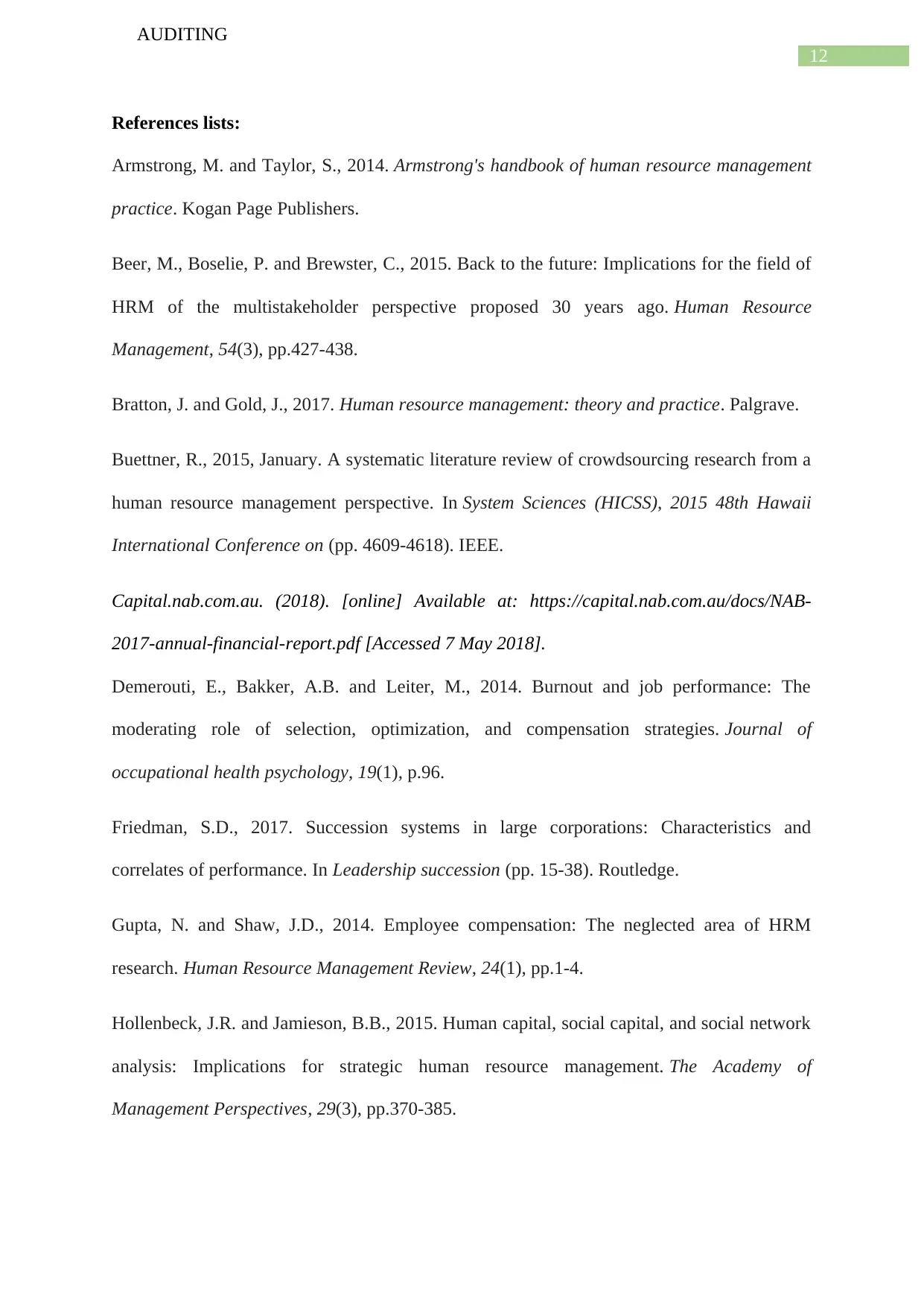
12
AUDITING
References lists:
Armstrong, M. and Taylor, S., 2014. Armstrong's handbook of human resource management
practice. Kogan Page Publishers.
Beer, M., Boselie, P. and Brewster, C., 2015. Back to the future: Implications for the field of
HRM of the multistakeholder perspective proposed 30 years ago. Human Resource
Management, 54(3), pp.427-438.
Bratton, J. and Gold, J., 2017. Human resource management: theory and practice. Palgrave.
Buettner, R., 2015, January. A systematic literature review of crowdsourcing research from a
human resource management perspective. In System Sciences (HICSS), 2015 48th Hawaii
International Conference on (pp. 4609-4618). IEEE.
Capital.nab.com.au. (2018). [online] Available at: https://capital.nab.com.au/docs/NAB-
2017-annual-financial-report.pdf [Accessed 7 May 2018].
Demerouti, E., Bakker, A.B. and Leiter, M., 2014. Burnout and job performance: The
moderating role of selection, optimization, and compensation strategies. Journal of
occupational health psychology, 19(1), p.96.
Friedman, S.D., 2017. Succession systems in large corporations: Characteristics and
correlates of performance. In Leadership succession (pp. 15-38). Routledge.
Gupta, N. and Shaw, J.D., 2014. Employee compensation: The neglected area of HRM
research. Human Resource Management Review, 24(1), pp.1-4.
Hollenbeck, J.R. and Jamieson, B.B., 2015. Human capital, social capital, and social network
analysis: Implications for strategic human resource management. The Academy of
Management Perspectives, 29(3), pp.370-385.
AUDITING
References lists:
Armstrong, M. and Taylor, S., 2014. Armstrong's handbook of human resource management
practice. Kogan Page Publishers.
Beer, M., Boselie, P. and Brewster, C., 2015. Back to the future: Implications for the field of
HRM of the multistakeholder perspective proposed 30 years ago. Human Resource
Management, 54(3), pp.427-438.
Bratton, J. and Gold, J., 2017. Human resource management: theory and practice. Palgrave.
Buettner, R., 2015, January. A systematic literature review of crowdsourcing research from a
human resource management perspective. In System Sciences (HICSS), 2015 48th Hawaii
International Conference on (pp. 4609-4618). IEEE.
Capital.nab.com.au. (2018). [online] Available at: https://capital.nab.com.au/docs/NAB-
2017-annual-financial-report.pdf [Accessed 7 May 2018].
Demerouti, E., Bakker, A.B. and Leiter, M., 2014. Burnout and job performance: The
moderating role of selection, optimization, and compensation strategies. Journal of
occupational health psychology, 19(1), p.96.
Friedman, S.D., 2017. Succession systems in large corporations: Characteristics and
correlates of performance. In Leadership succession (pp. 15-38). Routledge.
Gupta, N. and Shaw, J.D., 2014. Employee compensation: The neglected area of HRM
research. Human Resource Management Review, 24(1), pp.1-4.
Hollenbeck, J.R. and Jamieson, B.B., 2015. Human capital, social capital, and social network
analysis: Implications for strategic human resource management. The Academy of
Management Perspectives, 29(3), pp.370-385.
⊘ This is a preview!⊘
Do you want full access?
Subscribe today to unlock all pages.

Trusted by 1+ million students worldwide
1 out of 13
Related Documents
Your All-in-One AI-Powered Toolkit for Academic Success.
+13062052269
info@desklib.com
Available 24*7 on WhatsApp / Email
![[object Object]](/_next/static/media/star-bottom.7253800d.svg)
Unlock your academic potential
Copyright © 2020–2025 A2Z Services. All Rights Reserved. Developed and managed by ZUCOL.




